The value of money supply is always influenced by several factors. The first is the behavior of firms operating in the non-banking and household sectors. Secondly, commercial banks that have the ability to use credit funds not fully, that is, not issuing them in the form of loans, but leaving the resulting excess reserves at home. In this case, a change in the volume of deposits will be accompanied by a multiplier effect. Let's try to calculate the money multiplier.
Basic concepts
In order to understand what the essence of the concept of "money multiplier" consists of, you need to have a concept of two norms: reservation and deposit.
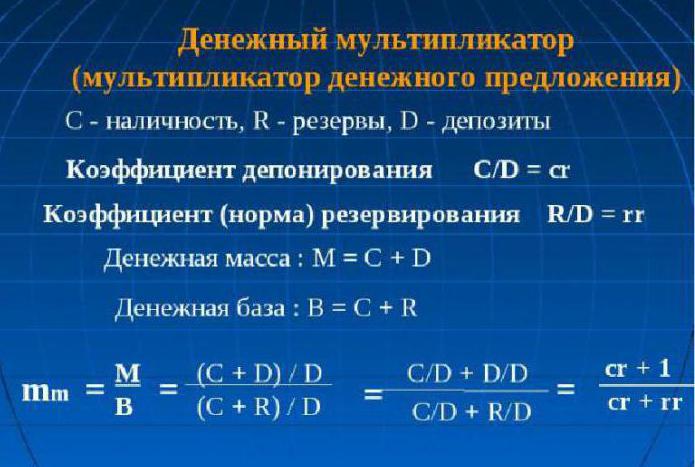
The reserve ratio shows the ratio of the volume of reserves to the share of deposits stored in the bank as reserve amounts, or the value of deposits:
rr = R / D.
The rate of deposit is defined as the ratio of cash to deposits:
cr = C / D.
It shows what the population is more inclined to: keep their savings in cash or on deposits.
It follows that the money multiplier, or, as economists call it, the money base multiplier is a coefficient indicating how many times the money volumes will be increased (reduced) when the money mass is increased (reduced) by one.
Like any economic multiplier, money can also work in both directions. If the Central Bank of the country plans to increase monetary volumes, then it will increase the monetary base, otherwise it will decrease.
The money supply multiplier is dependent on the norms described above. If the rate of deposit increases, then, accordingly, the multiplier decreases. On the other hand, an increase in the reserve ratio (that is, an increase in the share of the deposit in the bank, in the form of a reserve) reduces the value of the multiplier.
In theory
Economic theory determines that the money multiplier is equal to the value of the reverse rate of reserves of commercial credit institutions for mandatory storage at the Central Bank. In practice, it is calculated as the quotient of the monetary aggregate M2 to the monetary base. It is necessary to study the dynamics of the money base multiplier to control the money supply and inflation processes in the country. It is the money multiplier that is able to show a possible increase in the money supply without negative consequences in the form of rising consumer prices and inflation. The formula for calculating the money multiplier is simple, it is always more than one.
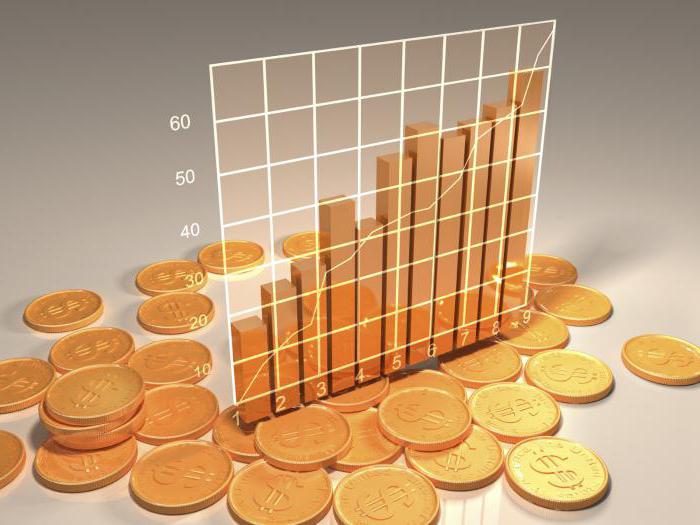
Almost
The expression for calculating the multiplier can be derived using the reservation rate: rr = R / D and the deposit rate: cr = C / D.
Since C = cr x D, and R = rr x D, we obtain the equalities:
M = C + D = cr x D + D = (cr + 1) x D
and
H = C + R = cr x D + rr x D = (cr + rr) x D.
Now divide the first equality into the second:
M / H = ((cr + 1) x D (cr + 1)) / (cr + rr) x D (cr + rr) = (cr + 1) / (cr + rr)
We obtain the equality: M = ((cr + 1) / (cr + rr)) x H,
from here:
M = multden x H multden = (cr + 1) / (cr + rr).
The money multiplier is the expression (cr + 1) / (cr + rr).
If we assume that C = 0 (that is, there is no cash), and without leaving the banking system the money supply rotates, the multiplier turns into a bank: multD = 1 / rr. Perhaps that is why the bank multiplier was called a simple money multiplier.
The essence of the money multiplier
It consists in a mechanism for increasing monetary volumes due to deposits opened by customers in banks, passing through the movement of non-cash funds through a system of non-state banks.
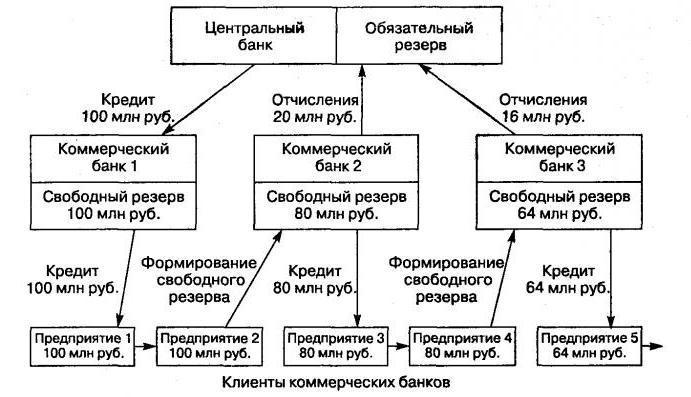
This mechanism is created subject to the presence of a banking system of two levels. In this case, the emission process takes place between the Central Bank (issue of cash in cash) and the system of commercial banks (issue of non-cash funds).
The increase in the volume of money in interbank circulation (the process of money multiplication) is due to the issuance by banks in the form of loans attracted to the deposit accounts of the funds of their customers, which they use when making various payments and settlement transactions. On the other hand, customers of borrowing banks can open deposits with third-party banks. Consequently, the total volume of deposits throughout the banking system almost always exceeds the amount of the originally created deposit.
Principle of animation
Each country has its own characteristics in distribution banking mechanisms. For example, in states with a command-and-distributive economy, emissions are carried out according to a directive lowered from above. In countries with a normal market mechanism, the banking system operates at two levels: the Central Bank and the layer of commercial banks. Therefore, emission under such a system has credit animation.
By properly managing this mechanism, the Central Bank has the ability to expand or narrow the emission processes of the entire institution of commercial banks. Economic theory makes it clear that the coefficient of growth (decrease) in total production for a gain in the mass of money (more precisely, its unit) is the multiplier. This value shows how many times the supply can change (increase or decrease) after an increase or decrease in the volume of deposits in the financial and credit sector.
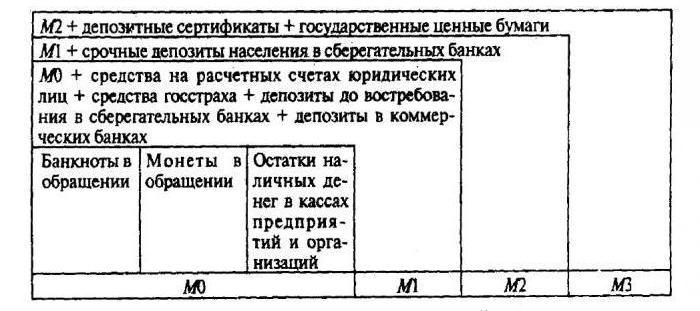
The monetary base is nothing other than reserves obligatory for payment by commercial banks and cash that is in circulation with the population outside the control of the Central Bank. Considering the coefficient of the money multiplier in the described aspects, we can derive the formula:
M - 1 / r
M = (1 + c) / (r + e + c).
Here, “c” refers to the ratio of cash to all deposits located in the country's banking system, “r” indicates mandatory reserve, and “e” indicates the ratio of available bank reserves to deposits.
Indicator value
The Central Bank regulates the mechanism for increasing (decreasing) the monetary volume by obligatory reserve accumulations in each commercial bank. The value of the money multiplier does not stand still. It fluctuates not only in space and time, but also from country to country. In countries with developed economies, this value may exceed the value of the first issue by more than two times.
We derive the formula
The money multiplier (the formula is described below) is easy to calculate:
m = Money supply / Money base = M / B.

The process of regulation by the Central Bank of the value of the money multiplier (k) entails the emergence of the concept of the monetary base. It is based on the very deposits of commercial banks that the Central holds, and the most liquid money is cash.
Money Base = M0 + money supply of required reserves (CB) + money supply on correspondent accounts with the Central Bank of the network of commercial financial institutions.
The money supply shows the amount of money that the Central Bank of the country can operate:
Money supply = base • multiplier.
Based on this formula, we can determine the money multiplier: this is the ratio of the money supply (M2) to the monetary base.
An inversely proportional relationship exists between the amount of required reserves from commercial financial institutions in the accounts of the Central Bank and the value of the money multiplier. And if the money multiplier decreases, the rate of required reserves pledged by commercial banks becomes higher. If the money multiplier grows, then the non-cash turnover increases (compared to cash), because the growth of the money base multiplier is directly related to the growth in cash and balances on correspondent accounts with the Central Bank.
Money Multiplier Dependence
As already mentioned, the size of the money multiplier depends on the norms of reservation and deposit. The higher they are, the greater the amount of reserves stored intact. The higher the proportion of cash in the masses that the population is not in a hurry to invest in deposits, the lower the multiplier value. This is clearly visible on the chart.
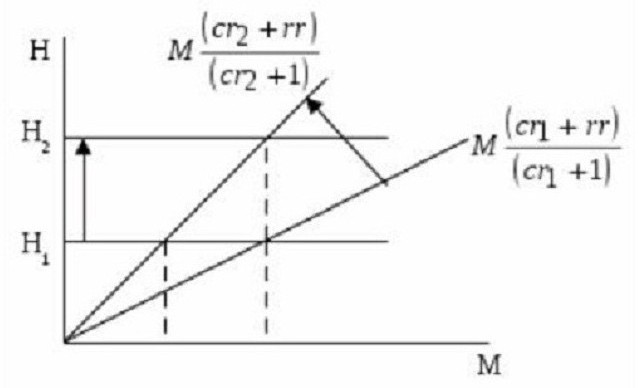
It reflects the ratio of the monetary base (N) through the monetary amount (M) and the multiplier, which is equal to (cr + 1) / (cr + rr). This shows that the tangent of the angle of inclination is equal to the ratio (cr + rr) / (cr + 1).
If n1 (the value of the monetary base) does not change, then the rate of deposit with growth from r1 to cr2 reduces the number of money multiplier and at the same time increases the slope of the curve reflecting the money supply (or money supply). As a result, this very sentence is reduced from M1 to M2. If it is necessary that the money supply (or supply) does not change with a decrease in the money multiplier, but is in a stable state at the level of M1, The central bank should increase the monetary base to N2.
From the foregoing, it is clear: an increase in the deposit rate reduces the value of the money multiplier. On the other hand, one can see an increase in the reserve ratio (an increase in the share of deposits stored as reserve reserves). That is, with an increase in excess bank reserves (not issued as loans to customers), the value of the money multiplier decreases.
Monetary multiplier
This is an economic coefficient characterizing the increase (or decrease) in excess of bank reserves. It is formed as a result of the creation of new deposits (non-cash money). They appear in the process of issuing loans to customers from additional free reserves received by the bank from the outside.
From this it becomes clear: the credit resources that left one commercial bank in the form of issued loans become the property of another bank. And he, in turn, provides his clients with this money, only in non-cash form. That is, a monetary unit issued by one commercial financial and credit institution creates credit reserves for another bank.
Reserve norms of commercial banks
The ability of a bank to create reserves in excess is limited by the function of forming required reserves by the structure of commercial banks. Their volumes are determined by the reserve norm, the rules of which are determined by law. The Central Bank calculates them as a percentage of bank liabilities. These reserves help the country's banking system to provide liquidity in adverse periods and to regulate the money supply in circulation:
M = 1 / Rn, where Rn is the reserve norm.
In order to calculate the entire mass of money that can be created by one monetary unit of excess reserves at a given reserve rate, determine the monetary multiplier:

Where:
- MM - monetary multiplier in a given time period;
- M0 - money supply outside of bank circulation;
- D - cash volumes stored on deposits of commercial banks;
- R - reserves of commercial banks held in correspondent accounts and at the cash desk.
Stable equilibrium in the money market can be shaken by the increased money multiplier. And even provoke inflation.
What does the bank multiplier depend on?
The magnitude of the monetary multiplier depends on the following factors:
- reserve requirements for commercial banks;
- a decrease in the demand for loans among the population and business and a simultaneous increase in borrowed interest, which usually entails a decrease in the issuance of loans and a decrease in the volume of deposits;
- use by customers of funds taken from banks for third-party cash payment transactions, which causes the suspension of the animation process and reduces its value;
- the increase in cash receipts to client accounts or the sale of a share of assets in the interbank market usually creates conditions for the growth of the multiplier.